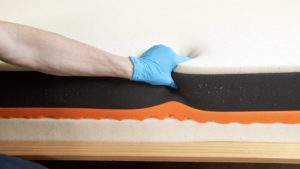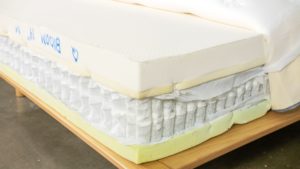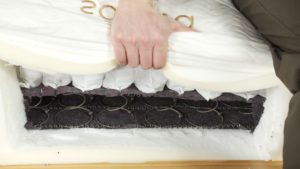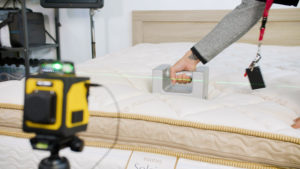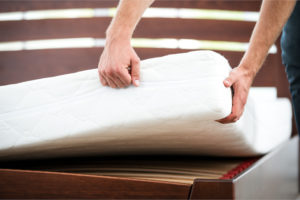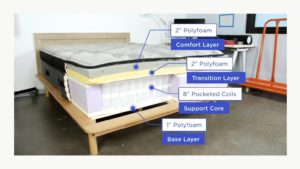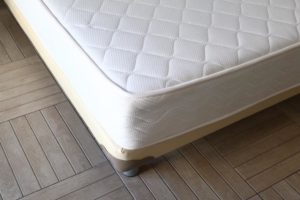When you buy through our links, we may earn a commission. Products or services may be offered by an affiliated entity. Learn more.
How to Make Your Mattress Firmer
Whether you bought a mattress that’s too soft or your firmness preferences changed over time, you may want to make the sleep surface feel firmer. Even if your mattress had been an ideal firmness, it may suffer wear and tear that causes it to sag and soften. A mattress that’s too soft doesn’t provide the support you need to maintain good posture. This leads to improper spinal alignment, which can cause stiffness and pain. Excessive sinkage can also inhibit movement and contribute to more heat buildup.
If your mattress is too soft but still in good shape, you may not need to replace it immediately. We share several simple ways to make your mattress more supportive. These methods can help extend the life of your mattress and enhance your comfort. We also discuss who may benefit from a firm sleep surface and how materials contribute to mattress firmness.
Let us help you find the perfect bed
Answer a few questions to find the right mattress for your unique needs
Tips to Make Your Mattress Firmer
An overly soft mattress can be frustrating, but you may be able to make it firmer with a few easy methods. The optimal approach depends on your situation.
Check Your Sleep Trial Period
Most online mattress companies offer sleep trials that range from three months to one year. These policies allow sleepers to assess the firmness level and determine whether the mattress is comfortable for them. If you purchased your mattress relatively recently and realized it’s too soft, check the manufacturer’s website to determine whether you are still within the trial period. If so, you may be able to return your mattress for a refund or exchange it for a firmer model.
Use a Mattress Topper
A mattress topper can fine-tune the overall firmness of your sleep surface. As its name suggests, a mattress topper is an extra layer that sits on top of the mattress under the fitted sheet. Most toppers are 1 to 4 inches thick, with those at the higher end of the range making a more noticeable difference. While toppers are often used to make a mattress feel plusher, a firm, dense topper can add support. Popular materials for firm mattress toppers include latex, memory foam, and polyfoam.
Latex: Latex mattress toppers are known for their durability, temperature regulation, and bouncy feel. Those made from natural latex are eco-friendly and hypoallergenic, while those made of synthetic latex are generally more affordable. Dunlop latex tends to be denser than Talalay latex, making this variety especially popular for those seeking a firmer sleep surface.
Memory Foam: Famed for its pressure-relieving qualities, memory foam molds to the sleeper’s body to encourage good spinal alignment. Although often used for a plush sleep surface, firmer, denser memory foam toppers are also available.
Polyfoam: Also called polyurethane foam, polyfoam mattress toppers are often the most affordable. High-density polyfoam toppers tend to be firmer, more durable, and more supportive than lower-density alternatives.
Flip or Rotate Your Mattress
Most manufacturers recommend regularly rotating your mattress to spread wear more evenly across the surface. Two-sided models should also be flipped, though many modern mattresses are not flippable. For best results, check the manufacturer’s instructions to find out how often to rotate or flip your mattress.
Place Your Mattress on a Firmer Base
A firm base can prevent excessive sagging and make a soft mattress feel more supportive. Some options include a box spring, a slatted base frame, or a divan base.
A box spring is a traditional mattress base that uses a fabric-wrapped frame and coils to support the mattress. Slatted base frames consist of connected planks. Those with less open space between the slats tend to be the most supportive. Popular in Europe, divan bases use platforms or springs for support. For a firmer surface, solid top and firm edge models are usually best.
Consider Using a Bunkie Board
A bunkie board can add support without significantly increasing the height of the sleep surface. These solid or slatted pieces usually measure 1 to 3 inches thick and go between a mattress and its base. They can be used in conjunction with nearly any base that isn’t adjustable. While affordable and simple to use, solid bunkie boards prevent airflow to the bottom of the mattress. This could make the mattress sleep hotter, particularly if you have a foam model with limited ventilation.
Put Your Mattress on the Floor
For a sturdy foundation, the floor is a quick, easy, and affordable solution. It provides consistent, even support to help limit sagging.
However, placing your mattress on the floor has potential drawbacks. Since limited air reaches the bottom of the mattress, the surface may retain heat. Moisture trapped between the mattress and floor could also lead to mold or mildew growth, so it’s important to prop the mattress up against the wall regularly to air it out. You’ll also need to clean the floor at least monthly to prevent dirt and debris buildup. Additionally, getting in and out of bed may be more difficult with such a low surface.
Replace the Layers in Your Mattress
Some mattresses are designed with removable layers that you can access through a zippered casing. If the comfort layer softens or you realize you need a firmer sleep surface, you can simply replace the top layer of the mattress. If your mattress has this feature, you can generally purchase a replacement layer and access detailed instructions through the manufacturer. Depending on the order of the layers, you may also be able to achieve a firmer feel by simply reordering the layers you already have.
Find the Right Room Temperature
Turning down the temperature can slightly increase the firmness of mattresses that contain memory foam. That’s because memory foam softens in response to heat and firms up in colder temperatures. While the difference may not be significant, adjusting your room temperature can be one of the easiest ways to tweak the feel of memory foam models.
Air Your Mattress Out
Mattresses, especially foam models, easily trap moisture from sweat and humidity. Excess moisture can lead to mold, mildew, and premature sagging. To avoid this, try airing out your mattress in a dry, clean spot in the sun once or twice a year. While regularly airing out your mattress can help prevent damage, a mattress that’s already moist and sagging may need to be replaced.
Consider Buying a New Mattress
If the above methods do not work or aren’t feasible, it may be a sign that it’s time for a new mattress. This is especially likely for mattresses that are extremely saggy or 7 to 10 years old and no longer comfortable. Investing in a new bed can prevent unnecessary pain and improve your sleep quality.
Who Is a Firm Mattress Best For?
While there is no “best” firmness for everyone, firm mattresses often benefit stomach and back sleepers, those over 130 pounds, and people who are sexually active.
A firm surface prevents sleepers from sinking too far into the mattress, which could jeopardize their spinal alignment and inhibit movement. However, because sleepers vary in their body types, needs, and preferences, mattress firmness is a personal choice.
Mattress Firmness, Explained
Mattress materials and construction affect the overall firmness. Firm models are available for every type of mattress, but some are more common than others. We explore mattress types in more detail to help you decide what’s best for you.
| Mattress Type | Description | Firmness |
|---|---|---|
| Innerspring | Innerspring mattresses have a coil support core that gives a bouncy, supportive feel. Varying gauges and coil patterns affect the firmness. | Because innerspring mattresses typically have a thin comfort layer, they tend to feel firmer. |
| Foam | Foam mattresses can include polyfoam, memory foam, or latex. They often mold to the body for exceptional pressure relief. | Due to foam’s conforming, foam mattresses tend to be softer. That said, firm models are available. |
| Latex | Latex is a highly durable, responsive material that blends support and pressure relief. Natural latex is especially popular for its comfort and longevity. | Latex reduces sinkage by spreading out body weight, which can make it feel firmer. Precise firmness levels vary depending on how the latex is manufactured. Denser Dunlop latex is usually firmer than Talalay latex. |
| Hybrid | Hybrid mattresses combine an innerspring support core with a thick comfort layer made of foam or latex. Different types of coils and comfort materials determine the overall feel. | A hybrid model’s firmness depends largely on its comfort system. Models with thin comfort systems typically offer a firmer sleep surface. A thick, pressure-relieving comfort system is likely to feel softer. |

Still have questions? Ask our community!
Join our Sleep Care Community — a trusted hub of sleep health professionals, product specialists, and people just like you. Whether you need expert sleep advice for your insomnia or you’re searching for the perfect mattress, we’ve got you covered. Get personalized guidance from the experts who know sleep best.

